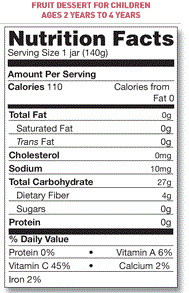The Nutrition Facts Panel for Infants
 |
| A Sample Nutrition Facts Panel of an Infant |
The infant food labels and
adult food labels vary. Though infant food labels also use the Nutrition Facts
format, the content inside is entirely different.
Total Fat
Adult food labels have the total fat content specifically stated as the amount of total fat in a serving of food. Since babies under two years of age require fat, the infant food label omits fat details and does not list calories from fat, saturated fat or cholesterol. Parents should also never restrict their infants’ fat intake. Infants must eat good healthy food that contain fat to fulfill their nutrition demands.
Adult food labels have the total fat content specifically stated as the amount of total fat in a serving of food. Since babies under two years of age require fat, the infant food label omits fat details and does not list calories from fat, saturated fat or cholesterol. Parents should also never restrict their infants’ fat intake. Infants must eat good healthy food that contain fat to fulfill their nutrition demands.
Serving Size
Serving sizes for infant food labels are based on the amount of foods these infants eat at one time. Adult food labels have serving sizes based on the average amounts that adults typically eat at one time. Serving size and portion size can be better understood by visiting the website www.firsteatright.com.
Serving sizes for infant food labels are based on the amount of foods these infants eat at one time. Adult food labels have serving sizes based on the average amounts that adults typically eat at one time. Serving size and portion size can be better understood by visiting the website www.firsteatright.com.
Daily Values
Infants and children aged below four years have food labels denoting Daily Value percentages for proteins, vitamins and minerals only. These labels do not list daily values for fat, cholesterol, sodium, potassium, carbonate and fiber unlike adult food labels, as these values are not set for children under four years of age.
Infants and children aged below four years have food labels denoting Daily Value percentages for proteins, vitamins and minerals only. These labels do not list daily values for fat, cholesterol, sodium, potassium, carbonate and fiber unlike adult food labels, as these values are not set for children under four years of age.


Comments
Post a Comment